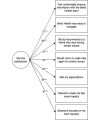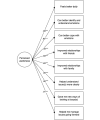Satisfaction, Perceived Usefulness, and Therapeutic Alliance as Correlates of Participant Engagement in a Pediatric Digital Mental Health Intervention: Cross-Sectional Questionnaire Study
- PMID: 37672321
- PMCID: PMC10512110
- DOI: 10.2196/49384
Satisfaction, Perceived Usefulness, and Therapeutic Alliance as Correlates of Participant Engagement in a Pediatric Digital Mental Health Intervention: Cross-Sectional Questionnaire Study
Abstract
Background: Although evidence suggests that digital mental health interventions (DMHIs) are effective alternatives to traditional mental health care, participant engagement continues to be an issue, especially for pediatric DMHIs. Extant studies of DMHIs among adults suggest that participants' satisfaction, perceived usefulness, and therapeutic alliance are closely tied to engagement. However, these associations have not been investigated among children and adolescents involved in DMHIs.
Objective: To address these gaps in extant DMHI research, the purpose of this study was to (1) develop and implement a measure to assess satisfaction, perceived usefulness, and therapeutic alliance among children and adolescents participating in a DMHI and (2) investigate satisfaction, perceived usefulness, and therapeutic alliance as correlates of children's and adolescents' engagement in the DMHI.
Methods: Members (children and adolescents) of a pediatric DMHI who had completed at least one session with a care provider (eg, coach or therapist) were eligible for inclusion in the study. Adolescent members and caregivers of children completed a survey assessing satisfaction with service, perceived usefulness of care, and therapeutic alliance with care team members.
Results: This study provides evidence for the reliability and validity of an adolescent- and caregiver-reported user experience assessment in a pediatric DMHI. Moreover, our findings suggest that adolescents' and caregivers' satisfaction and perceived usefulness are salient correlates of youths' engagement with a DMHI.
Conclusions: This study provides valuable preliminary evidence that caregivers' satisfaction and perceived usefulness are salient correlates of youths' engagement with a DMHI. Although further research is required, these findings offer preliminary evidence that caregivers play a critical role in effectively increasing engagement among children and adolescents involved in DMHIs.
Keywords: adolescent; child; children; coach; coaching; collaborative care; digital mental health intervention; engagement; internet-based coaching; internet-based therapy; mental health; patient-provider; perceived usefulness; satisfaction; service satisfaction; youth.
©Landry Huffman, Darian Lawrence-Sidebottom, Jennifer Huberty, Clare Beatty, Monika Roots, Kurt Roots, Amit Parikh, Rachael Guerra. Originally published in JMIR Formative Research (https://formative.jmir.org), 06.09.2023.
Conflict of interest statement
Conflicts of Interest: All authors are employed or contracted with Bend Health, Inc, which delivered the treatment used in this retrospective study. However, authors’ employment status and salary are not dependent upon the results of their research.
Figures





References
-
- Borghouts J, Eikey E, Mark G, De Leon C, Schueller SM, Schneider M, Stadnick N, Zheng K, Mukamel D, Sorkin DH. Barriers to and facilitators of user engagement with digital mental health interventions: systematic review. J Med Internet Res. 2021 Mar 24;23(3):e24387. doi: 10.2196/24387. https://www.jmir.org/2021/3/e24387/ v23i3e24387 - DOI - PMC - PubMed
-
- Garrido S, Millington C, Cheers D, Boydell K, Schubert E, Meade T, Nguyen Q. What works and what doesn't work? A systematic review of digital mental health interventions for depression and anxiety in young people. Front Psychiatry. 2019;10:759. doi: 10.3389/fpsyt.2019.00759. https://europepmc.org/abstract/MED/31798468 - DOI - PMC - PubMed
-
- Baumel A, Muench F, Edan S, Kane JM. Objective user engagement with mental health apps: systematic search and panel-based usage analysis. J Med Internet Res. 2019 Sep 25;21(9):e14567. doi: 10.2196/14567. https://www.jmir.org/2019/9/e14567/ v21i9e14567 - DOI - PMC - PubMed
-
- Liverpool S, Mota CP, Sales CMD, Čuš A, Carletto S, Hancheva C, Sousa S, Cerón SC, Peral PM, Pietrabissa G, Moltrecht B, Ulberg R, Ferreira N, Edbrooke-Childs J. Engaging children and young people in digital mental health interventions: systematic review of modes of delivery, facilitators, and barriers. J Med Internet Res. 2020 Mar 12;:e16317. doi: 10.2196/16317. doi: 10.2196/16317. - DOI - DOI - PMC - PubMed
-
- Lehtimaki S, Martic J, Wahl B, Foster KT, Schwalbe N. Evidence on digital mental health interventions for adolescents and young people: systematic overview. JMIR Ment Health. 2021 Apr 29;8(4):e25847. doi: 10.2196/25847. https://mental.jmir.org/2021/4/e25847/ v8i4e25847 - DOI - PMC - PubMed
LinkOut - more resources
Full Text Sources

